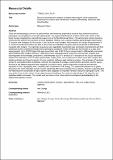Por favor, use este identificador para citar o enlazar a este item:
http://hdl.handle.net/10261/169866COMPARTIR / EXPORTAR:
 SHARE SHARE
 CORE
BASE CORE
BASE
|
|
| Visualizar otros formatos: MARC | Dublin Core | RDF | ORE | MODS | METS | DIDL | DATACITE | |

| Campo DC | Valor | Lengua/Idioma |
|---|---|---|
| dc.contributor.author | Oleaga, Ana | es_ES |
| dc.contributor.author | Obolo Mvoulouga, Prosper | es_ES |
| dc.contributor.author | Manzano Román, Raúl | es_ES |
| dc.contributor.author | Pérez Sánchez, Ricardo | es_ES |
| dc.date.accessioned | 2018-09-19T07:15:24Z | - |
| dc.date.available | 2018-09-19T07:15:24Z | - |
| dc.date.issued | 2018 | - |
| dc.identifier.citation | Ticks and Tick-borne Diseases 9(6): 1537-1554 (2018) | es_ES |
| dc.identifier.issn | 1877-959X | - |
| dc.identifier.uri | http://hdl.handle.net/10261/169866 | - |
| dc.description | 65 páginas, 9 gráficas, 7 tablas . -- The definitive version is available at http://www.elsevier.com | es_ES |
| dc.description.abstract | Ticks are hematophagous vectors of great medical and veterinary importance because they transmit numerous pathogenic microorganisms to humans and animals. The argasid Ornithodoros erraticus is the main vector of tickborne human relapsing fever and African swine fever in the Mediterranean Basin. Tick enterocytes express bioactive molecules that perform key functions in blood digestion, feeding, toxic waste processing and pathogen transmission. To explore new strategies for tick control, in this work we have obtained and compared the midgut transcriptomes of O. erraticus female ticks before and after a blood meal and identified the genes whose expression is differentially regulated after feeding. The transcript sequences were annotated, functionally and structurally characterised and their expression levels compared between both physiological conditions (unfed females and fed females at 2 days postengorgement). Up to 29,025 transcripts were assembled, and 9,290 of them corresponded to differentially expressed genes (DEGs) after feeding. Of these, 4,656 genes were upregulated and nearly the same number of genes was downregulated in fed females compared to unfed females. BLASTN and BLASTX analyses of the 29,025 transcripts allowed the annotation of 9,072 transcripts/proteins. Among them, the most numerous were those with catalytic and binding activities and those involved in diverse metabolic pathways and cellular processes. The analyses of functional groups of upregulated DEGs potentially related to the digestion of proteins, carbohydrates and lipids, and the genes involved in the defence response and response to oxidative stress, confirm that these processes are narrowly regulated in ticks, highlighting their complexity and importance in tick biology. The expression patterns of six genes throughout the blood digestion period revealed significant differences between these patterns, strongly suggesting that the transcriptome composition is highly dynamic and subjected to important variation along the trophogonic cycle. This may guide future studies aimed at improving the understanding of the molecular physiology of tick digestion and digestion-related processes. The current work provides a more robust and comprehensive understanding of the argasid tick digestive system. | es_ES |
| dc.description.sponsorship | This research was funded by project AGL2013-42745-P granted by the Spanish Ministry of Economy and Competitiveness. | es_ES |
| dc.language.iso | eng | es_ES |
| dc.publisher | Elsevier | es_ES |
| dc.relation | info:eu-repo/grantAgreement/MINECO/Plan Estatal de Investigación Científica y Técnica y de Innovación 2013-2016/AGL2013-42745-P | es_ES |
| dc.relation.isversionof | Postprint | es_ES |
| dc.rights | openAccess | en_EN |
| dc.subject | Argasid | es_ES |
| dc.subject | Ornithodoros erraticus | es_ES |
| dc.subject | Transcriptomes | es_ES |
| dc.subject | RNA-seq | es_ES |
| dc.subject | Midgut | es_ES |
| dc.subject | Blood digestion | es_ES |
| dc.title | De novo assembly and analysis of midgut transcriptome of the argasid tick Ornithodoros erraticus and identification of genes differentially expressed after blood feeding | es_ES |
| dc.type | artículo | es_ES |
| dc.identifier.doi | 10.1016/j.ttbdis.2018.06.018 | - |
| dc.description.peerreviewed | Peer reviewed | es_ES |
| dc.relation.publisherversion | https://doi.org/10.1016/j.ttbdis.2018.06.018 | es_ES |
| dc.identifier.e-issn | 1877-9603 | - |
| dc.embargo.terms | 2019-08-01 | es_ES |
| dc.rights.license | https://creativecommons.org/licenses/by-nc-sa/4.0/ | es_ES |
| dc.contributor.funder | Ministerio de Economía y Competitividad (España) | es_ES |
| dc.relation.csic | Sí | es_ES |
| oprm.item.hasRevision | no ko 0 false | * |
| dc.identifier.funder | http://dx.doi.org/10.13039/501100003329 | es_ES |
| dc.contributor.orcid | Oleaga, Ana [0000-0002-8019-7354] | es_ES |
| dc.contributor.orcid | Manzano Román, Raúl [0000-0002-0165-2604] | es_ES |
| dc.contributor.orcid | Pérez Sánchez, Ricardo [0000-0001-8875-439X] | es_ES |
| dc.type.coar | http://purl.org/coar/resource_type/c_6501 | es_ES |
| item.languageiso639-1 | en | - |
| item.fulltext | With Fulltext | - |
| item.openairecristype | http://purl.org/coar/resource_type/c_18cf | - |
| item.cerifentitytype | Publications | - |
| item.grantfulltext | open | - |
| item.openairetype | artículo | - |
| Aparece en las colecciones: | (IRNASA) Artículos | |
Ficheros en este ítem:
| Fichero | Descripción | Tamaño | Formato | |
|---|---|---|---|---|
| De novo assembly and analysis of midgut transcriptome of the argasid tick Ornithodoros erraticus.pdf | Artículo principal | 1,08 MB | Adobe PDF |  Visualizar/Abrir |
CORE Recommender
SCOPUSTM
Citations
19
checked on 22-abr-2024
WEB OF SCIENCETM
Citations
19
checked on 22-feb-2024
Page view(s)
386
checked on 24-abr-2024
Download(s)
417
checked on 24-abr-2024
Google ScholarTM
Check
Altmetric
Altmetric
Este item está licenciado bajo una Licencia Creative Commons

